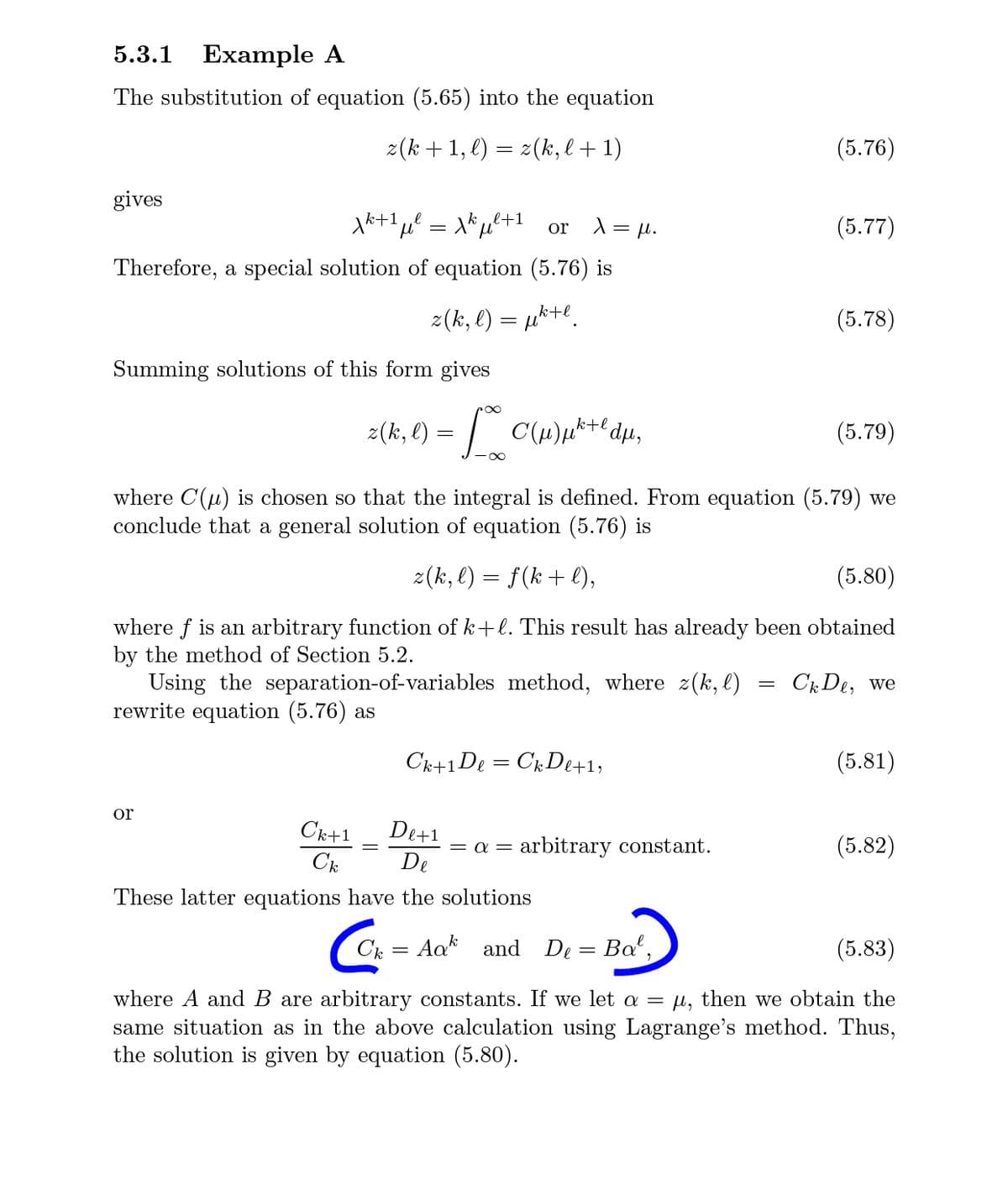or De+1 Ck+1 Ck = a = arbitrary constant. De (5.82) These latter equations have the solutions Ck = Aa and De = Ba, (5.83)
or De+1 Ck+1 Ck = a = arbitrary constant. De (5.82) These latter equations have the solutions Ck = Aa and De = Ba, (5.83)
Advanced Engineering Mathematics
10th Edition
ISBN:9780470458365
Author:Erwin Kreyszig
Publisher:Erwin Kreyszig
Chapter2: Second-order Linear Odes
Section: Chapter Questions
Problem 1RQ
Related questions
Question
Explain the determine blue

Transcribed Image Text:5.3.1
Example A
The substitution of equation (5.65) into the equation
2(k + 1, l) = z(k, l+ 1)
(5.76)
gives
Ak+1u = x*u'+1 or
X= µ.
(5.77)
Therefore, a special solution of equation (5.76) is
z(k, l) = µk+e.
(5.78)
Summing solutions of this form gives
k+l
2(k, l) =
(5.79)
where C(u) is chosen so that the integral is defined. From equation (5.79) we
conclude that a general solution of equation (5.76) is
z(k, l) = f(k+ l),
(5.80)
where f is an arbitrary function of k+l. This result has already been obtained
by the method of Section 5.2.
Using the separation-of-variables method, where z(k, l)
rewrite equation (5.76) as
Ck De, we
Ck+1De = CkDe+1,
(5.81)
or
Ck+1
De+1
arbitrary constant.
(5.82)
Ck
De
These latter equations have the solutions
Ck = Aak and De = Ba,
(5.83)
where A and B are arbitrary constants. If we let a = µ, then we obtain the
same situation as in the above calculation using Lagrange's method. Thus,
the solution is given by equation (5.80).
Expert Solution
This question has been solved!
Explore an expertly crafted, step-by-step solution for a thorough understanding of key concepts.
Step by step
Solved in 4 steps

Knowledge Booster
Learn more about
Need a deep-dive on the concept behind this application? Look no further. Learn more about this topic, advanced-math and related others by exploring similar questions and additional content below.Recommended textbooks for you

Advanced Engineering Mathematics
Advanced Math
ISBN:
9780470458365
Author:
Erwin Kreyszig
Publisher:
Wiley, John & Sons, Incorporated

Numerical Methods for Engineers
Advanced Math
ISBN:
9780073397924
Author:
Steven C. Chapra Dr., Raymond P. Canale
Publisher:
McGraw-Hill Education

Introductory Mathematics for Engineering Applicat…
Advanced Math
ISBN:
9781118141809
Author:
Nathan Klingbeil
Publisher:
WILEY

Advanced Engineering Mathematics
Advanced Math
ISBN:
9780470458365
Author:
Erwin Kreyszig
Publisher:
Wiley, John & Sons, Incorporated

Numerical Methods for Engineers
Advanced Math
ISBN:
9780073397924
Author:
Steven C. Chapra Dr., Raymond P. Canale
Publisher:
McGraw-Hill Education

Introductory Mathematics for Engineering Applicat…
Advanced Math
ISBN:
9781118141809
Author:
Nathan Klingbeil
Publisher:
WILEY

Mathematics For Machine Technology
Advanced Math
ISBN:
9781337798310
Author:
Peterson, John.
Publisher:
Cengage Learning,

